Karamay’s “The Bubble” No. 1 Oil Well
In a remote corner of China’s western Xinjiang region, an interesting sculpture known as “The Bubble” in Karamay can be found. While it was erected as a monument to the region’s first oil well, it’s similarity to the Bean in Chicago, USA has also brought plenty of controversy.
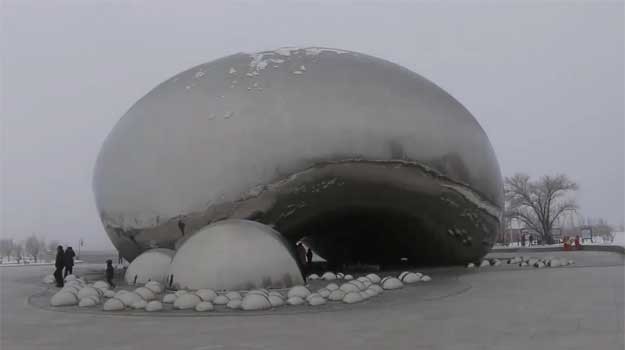
Leave it to Xinjiang to create a monument that is both beautiful and highly controversial all at the same time. This is Karamay’s No. 1 oil well, often referred to as “The Karamay Bubble,” and if you think it looks extremely familiar, you’re not alone.
Karamay is a city in northern Xinjiang whose entire history can be traced back to black oil that was discovered bubbling out of the ground by an entrepreneurial Uyghur man named Sayram (Salimu or 赛里木).
For decades, a humble monument to the city’s precious oil stood on this very spot. It wasn’t until August of 2015 that a newer, bigger monument was completed and opened to the public.
Karamay Bubble Introduction [Video]
Check out the video below for my short introduction to this new monument in Karamay, Xinjiang.
Check out more great Xinjiang videos on the FarWestChina YouTube channel!
Controversy Around “The Bubble”
When the new design for Karamay’s No. 1 oil well was first unveiled, people outside of China were quick to point out the similarities with the famous Cloud Gate sculpture in Chicago, USA, affectionately referred to as “The Bean.”
Even Anish Kapoor, the designer of the Chicago Bean, chimed in, saying, “It seems that in China today it is permissible to steal the creativity of others.“
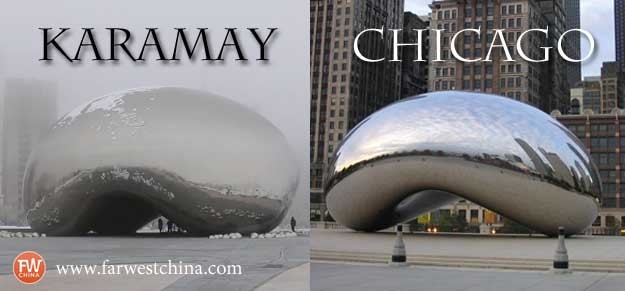
But is the sculpture a direct copy?
I decided to make a visit to see for myself how the two monuments compare.
Karamay’s Bubble vs Chicago’s Cloud Gate
Before I discuss the details of what makes these two monuments different, let’s get one thing out of the way: there is no doubt that the design of “The Bubble” was directly influenced by Chicago’s Cloud.
However, it’s not an exact replica.
I’m not here to debate whether this represents an infringement of rights; rather I want to give a first-ever detailed glimpse at Karamay’s Bubble and let you decide for yourself. There are a number of key differences I noticed between the two:
- The shape: While Chicago’s Bean is more elongated in shape (hence the nickname “The Bean”), the Karamay No. 1 oil well monument has a more rounded, bubble-like shape.
- Points of contact: If you look closely, you’ll notice that the Karamay Bubble connects to the ground at four distinct points, creating 4 possible points of entry inside. The Chicago Cloud Gate has only two points of contact and therefore only two possible points of entry.
- Additional elements: Unlike the Chicago monument which stands alone in a park, the Karamay Bubble is surrounded by over 200 additional stainless-steel “bubbles” to complete the idea that this is oil gurgling out of the ground.
So do these components constitute enough of a difference in design? Or better yet, does it even matter? Leave a comment below with your thoughts. I’m interested to hear!
Brief History of Karamay’s No. 1 Oil Well
Now that we’ve discussed the controversy, for those who are interested I want to share with you a brief history of why this monument even exists.
You see, in the early 1950’s, soon after the People’s Republic of China was first established, a number of geological survey teams were sent out to explore the desert around what is now known as Karamay. At the time, the land was nothing more than a barren desert, which is crazy considering how much water is there now.
They finally decided on a spot, and a crew of 36 men were sent to dig Xinjiang’s first oil well. It was completed on October 29th, 1955, a date which Karamay has adopted as its birthday.
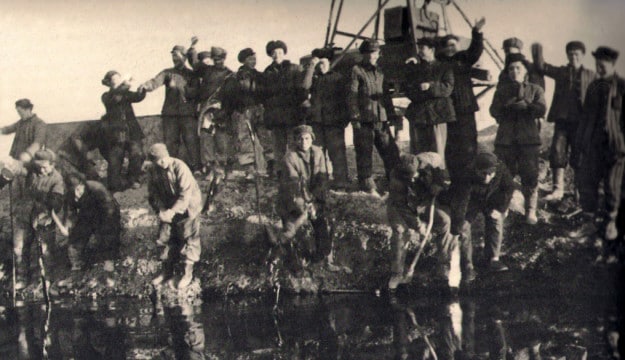
Decades later, after the well had run dry, a simple monument was erected on the spot, which at the time was a couple kilometers outside of town. As Karamay has grown, though, it has swallowed up the monument with new neighborhoods, malls, and even Karamay’s first university.
So in 2013 the city decided to upgrade the small monument to include the bubble sculpture, an outdoor theater space, and a park. Everything was completed mid-2015.
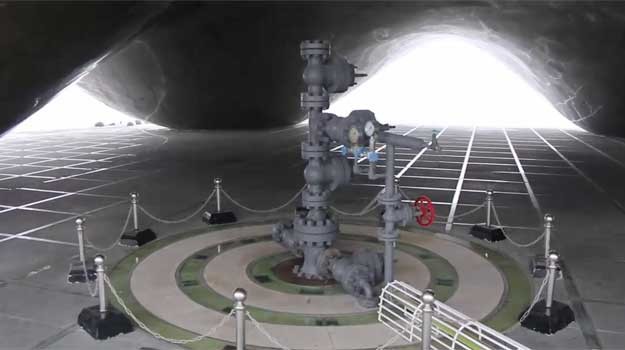
Final Thoughts | Karamay’s Bubble
While I don’t recommend making a visit to Karamay in the winter (we were WELL into the negative temperatures when I filmed that video!), the Karamay Bubble is certainly a unique place to visit when you pass through.
It’s a beautiful park, an interesting monument, and best of all … it’s free.
What do you think of the monument? Leave a comment below with your own thoughts.





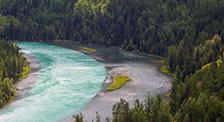
Josh,
Is it true that there more Hans than Uyghers in Karamay? Heard that the richest city in Xingxiang. Believed the Uyghers here are also well off.
[Reply]
Josh Summers on January 20th, 2016 at 8:23 am
Because Karamay is a relatively young city (less than six decades), it has an unusually unbalanced population for Xinjiang. The vast majority of residents are Han, although there are small pockets of Uyghur and Kazakh.
It is quite well-off, although the low cost of oil at the moment is tightening their budget.
[Reply]
Hi Josh
Im from Thailand
I’ve follow your blog for a while , you’ve done great works here to give us many interesting in such a beautiful place like Xinjiang and your book ultimately give me tons of useful informations
I’ve plan to traveling in Xinjiang in this February , Im so excited !!
But I have some worry about what Uyghur peoples think about Thai people now from what our Government did to those Uyghu refugees last year , should I concern about this topic
Thank you
[Reply]
Josh Summers on January 20th, 2016 at 8:24 am
Hey Sittipong, thanks for your comment! I’ve responded to you via email already, but for everybody else I’ll just say that most people in Xinjiang probably wouldn’t know just by looking at you that you are Thai, so I wouldn’t worry.
[Reply]
You are right Josh. Does it really matter? Besides the pollution makes it look entirely different.
[Reply]
Josh Summers on January 20th, 2016 at 8:24 am
Ha! So true.
Although it’s not really pollution that you’re seeing, I just happen to be there when Karamay had a terribly foggy day :)
[Reply]
Josh, sorry to say but I think this is much to do about nothing.That said I’m always interested in your news and commentary about Xingyang. Nest, John
[Reply]
Josh Summers on January 20th, 2016 at 8:25 am
No problem, John! You should tell that to Chicago, though…they think there’s a lot more than “nothing” here :)
[Reply]
Josh,
Your reports are clean, well shot and edited, and you look comfortable on camera. But you need to ramp up your journalistic skills and writing. For example, what do you think of the Karamay Bubble? Put some “edge” into it: is it a blatant ripoff? What’s the back story on the design? I happen to believe it’s cooler than the abstract blob in the Windy City.
If you’re inclined, you could string for CNN if your reports get better. Not a bad thing to aim for. You have great feature material all around you.
Marc
[Reply]
Josh Summers on January 20th, 2016 at 8:26 am
Thanks so much, Marc. I wasn’t really going for “hard-hitting new report” here, I guess, but I am still searching out my niche. I have a lot to learn, I know.
I appreciate your thoughts – and your kind words about the video quality!
[Reply]
OMG. The sacred sites of oil exploration horrify me, having been born in Odessa, Texas when the oil boom was on. I am reading The Family Secrets concerning oil exploration, worldwide, Baku and the glutting of the globe for greed and technology! It will make your hair stand on end. I love the BUBBLE, why not? They made a 20% change from the original and that is all you need for copyright!
You are living in a fascinating region of the world! Thanks for sharing.
[Reply]
Josh Summers on January 20th, 2016 at 8:26 am
Thanks, Sally! Glad you like the Bubble :)
[Reply]
Always interested, Josh, in your communiqués from Xinjiang Province, which my husband and I first visited in 1980. I say, bully for the person who first detected a likeness between the Chicago Bean and the Chinese Bubble. As far as copyright infringement or other legal problems are concerned, my reaction is FUHGEDDABOUDIT!!!!!!
[Reply]
Josh Summers on January 20th, 2016 at 8:27 am
Haha! That’s great. Thanks for sharing, Dr. Gretchen!
[Reply]
My uneducated guess is that Karamay’s bubble would be mopped up if it was within reach of the US or European court.
That being said, I liked the static and video reports, and also the idea that you traveled to Karamay to let me know about this monument.
Thanks !
[Reply]
Josh Summers on January 20th, 2016 at 8:28 am
My pleasure, Laurent. Glad you enjoyed it!
And you’re right, as long as China has jurisdiction over Karamay instead of US or European courts, nothing will happen here. It’s just egg on the face of Xinjiang.
[Reply]
Copied or coincidence ? Anyway the law suit will help popularise it, well done Chicago :)))
[Reply]
Josh Summers on January 20th, 2016 at 8:28 am
Yea, I think that’s exactly what happened. Chicago’s big hoopla just added to the publicity of the monument in Xinjiang!
[Reply]
Very cool. Great report and visuals as always Josh. If one could speak with the two designers of the bubbles, we could establish who influenced who. Otherwise, who cares. I like the history and purpose of the Xinjiang bubble better than a park decoration in Chicago.
[Reply]
Josh Summers on January 20th, 2016 at 8:29 am
Well, the Chicago Bean was designed and constructed about a decade before the Karamay Bubble, so I think it would be hard to establish that the Chicago designer was influenced by the Karamay one!
Either way, thanks so much for your comment, Audrey! Always great to hear from you guys :)
[Reply]
As with many things there, it looks like a direct knockoff to me. I wouldn’t however ask you to put an edge into your writing as pure information is all that the travelers need.
Thanks!
[Reply]
Josh Summers on January 20th, 2016 at 8:30 am
I’m pretty edgy as it is, Mitch. Adding more would be potentially disastrous. :)
[Reply]
Very interesting – I believe I visited the original monument in 1999… I’ll have to dig up some old photos – the new one is a bit more grand :) Thanks for the post.
[Reply]
Josh Summers on May 25th, 2016 at 12:08 am
Ha! Definitely different, isn’t it?
[Reply]